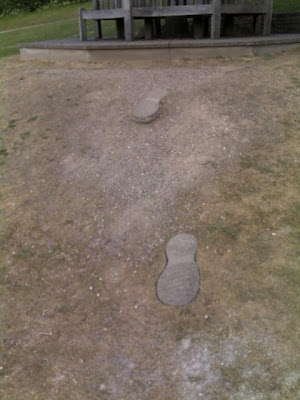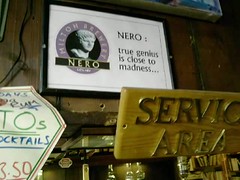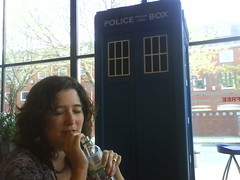The Dr and I have spent Christmas eating too much, drinking even more, seeing some chums and enjoying – for the Dr at least – a busman's holiday. If that busman also worked in museums.
1.
Cold War Modern – Design 1945-1970 (Victoria and Albert Museum until 11 January 2009)
There's a lot of big ideas crammed into this exhibition – even for such a large space. As
I've blogged before, the post-war period saw a punch-drunk sweeping away of the past in favour of big, bold ideas in art, design and ideology. Perhaps it was the horror and damage done by the Second World War, perhaps the burgeoning threat of mutually assured destruction, but the artefacts of that time spell out a bleak and awful picture of the world, with a yearning for something better.
I liked how they put astronaut and environment suits up close with the fab and groovy gear available off the peg in the Portobello Road. There's examples of revolutionary politics from all round the world; '68 and Nam and Che, both the hope and frenzied propaganda from all sides.
Into this context they squeeze clips of Ipcress, Bond and Strangelove, all featuring big, futuristic set design by Ken Adam (the sketch for the play area where Goldfinger spells out to his hoods the details of Operation Grand Slam is, marvellously, called “the Rumpus Room”). These sit beside drawings and photographs of grand housing projects on both sides of the Iron Curtain, and then plans for domes over New York or cities on the Moon. On big screens high above the space stuff, the “stargate” sequence from the end of 2001: A Space Odyssey faces the arrival of Kris Kelvin on the space station above Solaris. East and West's visions of man reaching for cold, unfathomable space - opposite and yet so much the same.
In all this grandeur, there's a disturbing desperation. I wondered who they – the hopeful people who dreamt up these things – thought they were kidding. The problem with planning such a monumental new programme of building and social organisation, of so radically creating a new world, is that it assumes we've already lost this one.
(Afterwards, we had coffee and pastries while enjoying the William Morris-styled bit of the cafe, but there wasn't enough light for my camera-phone to get pictures. And the V&A shop proved very good for small trinkets and silliness for the Dr's stocking. No, she didn't just get coal and birch twigs.)
2.
Darwin (a.k.a Big Idea exhibition)Natural History Museum until 19 April 2009
“Before Darwin, the great majority of naturalists believed that species were immutable productions, and had been separately created. Today, his theory that they undergo modification and are all descendants of pre-existing forms is accepted by everyone (or by everyone not determined to disbelive it). Most people would, if asked, find it hard to explain why.”Steve Jones, Almost Like a Whale, p. xxii.
Like Jones' book, the Natural History Museum exhibition shows how Darwin came to his radical proposition of the history of species as a family tree of connected, branching variance – and then updates the evidence. We see the specimens of birds and beetles Darwin himself caught on his boat trip round the world, and then – like Jones – how 150 years of scientific hard graft has honed and bolstered that central idea, filling in the gaps Darwin himself acknowledged.
There's stuff on why Darwin delayed publishing his findings for so long, and a glimpse of his home life. There are even real creatures to coo at – a lizard called Charlie who apparently doesn't like it if you tap the glass, and a fat, ugly toad that looks like a green and yellow cow pat.
There's sensibly no apology at all to the dissenters, and no mention of “intelligent design”. Yet, the Dr noted they kept speaking of evolution as a “theory”. Her research elsewhere has shown a strange shift in the 1980s and 90s; telly and radio before that rarely felt the need to qualify Darwin's idea as a “theory”, now it's rare that they don't.
That said, the exhibition is keen to explain that, in science, a theory isn't the same as a guess; it's a carefully worked out and tested hypothesis from evidence, one from which you can make accurate predictions. I thought that was what we called a “fact”, but apparently not. Wikipedia boasts a whole page discussing
evolution as theory and fact. But why qualify Darwin like that? We don't talk of Newton's “theory of gravity” - which the work of Einstein (and Eddington) actually disproved (or, at best, radically refined).
3.
Byzantium 330-1453Royal Academy of Arts until 22 March 2009
By the time we got to this one in the mid-afternoon, London was swollen with tourists enjoying the hilarious ratio of euro to pound. They crowded the pavements and train stations, and – a bit to our surprise – the Royal Academy. Yes, let's go to England for the
closing down January sales and while we're at it shell out to see some trinkets from the wrong side of Europe...
The exhibition apes the dark and churchy feel of Istanbul's grand churches and mosques, from which the objects come. Boris Johnson's surprisingly superb two-part series
After Rome had important things to say about Western prejudice; not only the destruction of the city during the Crusades (and the legacy of that word in the Middle East) but also the fact that Constantinople was a second Rome, continuing the traditions and learning of the Empire long after the West has succumbed to its Dark Age. The Renaissance was less a “rebirth” as the Western powers learning to stop bashing their neighbours and instead start borrowing their books...
(I meant to post my thoughts on Seville and Cordoba ages ago, having visited in September. And then there's Boris going and saying a whole load of stuff I wish I'd thought of...)
In the exhibition, I struggled to follow particular ideas or stories. The exhibition seemed to assume a robust, academic knowledge on the part of its visitors – artefacts, for example, were described as being from Harare or Sinai without any explanation of where these were or on what terms they stood against Byzantium / Constantinople at the time. The Dr, meanwhile, muttered that it grouped different traditions all in together – Coptic (especially) and Ptolemaic with Orthodox and Islamic. It seemed less an attempt to explain or explore the history of and our relationship with the Middle East as a collection of pretty, glittery things.
Favourite artefact: a painting of monks being tempted off a ladder to heaven by spindly, sneaky devils. Weirdly they had postcards of this in the shop after – they almost never have the ones that I like.
4.
Babylon – Myth and RealityBritish Museum until 15 March 2009
Two years ago, the Doctor and I marvelled down the brilliant blue streets of Babylon, up to the Ishtar Gate. It's vast, it's bright blue and it was nicked by German archaeologists from what's now Iraq and reconstructed in
Berlin's Pergamon museum. If you can, go see that before you see this exhibition, which struggles to convey the scale of the Biblical city, squeezed as it is into the upstairs of the old Reading Room.
“Many individuals' first encounter with the name of Babylon will have come from the Old Testament. Of the momentous events that took place in the city, not the least concerned the Judaean exiles taken from Jerusalem by Nebuchadnezzar as part of a conventional military campaign. The repercussions of the Babylonian Captivity in theology, culture and art are still with us, while our knowledge of the historical events has been enhanced by some of the world's most important cuneiform texts.”IL Finkel and MJ Seymour (eds.), Babylon – Myth and Reality, p. 142.
The Old Testament paints Babylon as cruel conqueror and enslaver. Daniel and his pals Shadrach, Meshach and Abednego are remarkable because they stand up to Nebuchadnezzar – the implication being that no one else ever dared to. Interestingly, the section on Rastafarianism linked Babylon to Western greed and commercialism, not to the West's history of enslavement.
Brilliantly, the exhibition closes with those who identify not with the oppressed but the oppressors. It is pretty out-spoken about the site today and the damage done by, first, Saddam Hussein and then the US army. For both, the ancient site is an excuse for extraordinary grand-standing, on a scale beloved by tyranny.
There's comparatively little of the actual city here: some bits of bright blue stone, some small, ancient objects. There are models of the street up to the Ishtar Gate and of the Etemenanki ziggurat – also known as the tower of Babel. Tiny little
Scale Guys help suggest the ma
hoossive. But mostly it's about the how the city's been interpreted since it fell. It compares representations of the city in the Bible or myth (while never quite daring to suggest they're the same thing) with the evidence uncovered since the 19th century, and it discusses how Babylon continues to play a part in stories. There's a picture of a
Rod Lord-designed Babel fish and the cover of Hollywood Babylon.
With the same mythic buildings and characters depicted by different art traditions over the centuries, this is an exploration of stories and cultures bleeding into one another, becoming scared as they help define – or at least shape – identity and power. The real ninth century BC Assyrian queen, Sammu-rammat, for example, ends up worshipped as the goddess Semiramas by the Greeks.
We emerged into a crowded museum, the Dr spitting feathers as a huge Biblical tour stopped for no man or woman or child. She was not incensed at their rudeness but the nonsense they were being told, provenance and context completely ignored to make chosen objects fit the pre-agreed story.
5.
Taking LibertiesBritish Library until 1 March 2009
This one is exemplary: a collection of iconic documents brilliantly grouped and explained so that visitors are challenged on their own political ideas. There's
Magna Carta, or the
death warrant for Charles I, the
1832 Reform Act, a copy not just of the
Beveridge report in English but in half a dozen other languages as the world looked in awe at our pioneering social wheeze. It's fascinating enough just to gaze on these things, and all of it for free. But there's more.
The documents – and explanations, associated items and illustrations – are grouped under broad headings like “Rule of law” or “Freedom of speech”. There's stuff on Lords reform and on whether referenda are actually democratic, CCTV and a national DNA database – all sorts of complex, knotty stuff. It's brilliant at simply and concisely laying out the different sides on a given issue and then getting you to do some thinking. In fact, it's a shame this isn't a permanent exhibition. It's the only one of the five discussed here I'd want to mooch round a second time.
At the end of each section you're encourage to vote on three or four questions, choosing a statement from a list. To do this, you have to scan your wristband, so the machine remembers your answers. At the end of the exhibition, you can see how you voted compared to the mass of other visitors, and where on a political graph your votes place you.
A couple of times, what I'd seen in the exhibition made me at least reconsider my natural instincts at the poll. But I also found on several occasions I didn't quite agree with
any of the statements, that there were exceptions or at least things I'd want to clarify. So there was some fudging towards the statement that best exemplified by fluffy, why-can't-we-all-just-get-along sensibilities.
And that's, I think, the one thing the exhibition lacked: something about party politics, the Whip system, the way it reduces any kind of issue to a simplistic yes or no, your answer as much dependent on the will of HQ as your own insight or conscience. (I'd quote Paxman on just this point in
The Political Animal, but we seem to have leant it to someone.) There's nothing on political compromise, on supporting something because that's supporting your team.
The exhibition raises an eyebrow at the Levellers and Chartists – whose ideas that were so terrifying and radical in their own day are now rights we take for granted. But it doesn't explain why that happens. It's a great strength and a great weakness that our system allows change only in a series of small, hard-negotiated steps. That's fundamental because you can't understand the liberties and law we have now without understanding how these decisions are made.

























